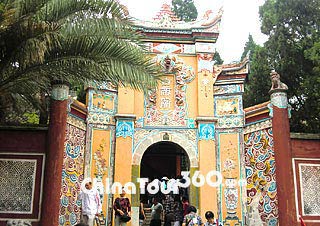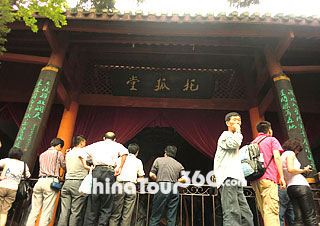 White Emperor City, Fengjie
White Emperor City, Fengjie Orphan-entrusting Hall
Orphan-entrusting Hall A Statue in White Emperor City
A Statue in White Emperor City
Cruising downstream along the Yangtze River Fengjie for about 8 km (5 miles), you will find many buildings with hanging eaves standing among verdant trees on the mountains, and that is the White Emperor City (Bai Di Cheng). It is located at the northern bank of the Yangtze River, near the mouth of Qutang Gorge. Facing the Yangtze River is the best place to see the magnificent view of Kui Gate. It has long been a famous place since ancient times. Many Chinese poets, such as Li Bai, Du Fu, Bai Juyi, Su Shi, and Lu You, visited the city and left lots of poems, thus White Emperor City is also named the City of Poems.
At the end of the Western Han Dynasty (206 BC - 24 AD) when the throne was usurped by Wang Mang, Gongsun Shu, a general following Wang Mang, made Sichuan a separatist regime, and also wanted to be an emperor. When he heard that a well in the Ziyang Town at the bank of Qutang Gorge always released white fog which looked like a white dragon, he spread a rumor that the white fog was a white dragon, which indicated he could become an emperor (a dragon was believed to be the incarnation of an emperor in ancient China). In 25 AD, Gongsun Shu proclaimed himself White Emperor (Baidi), and renamed the town White Emperor City (Baidi City), and the mountain White Emperor Mountain (Baidi Mountain). At that time, many places suffered from wars, but people in White Emperor City had a peaceful life, so they built a White Emperor Temple and a statue of Gongsun Shu to commemorate him after he died.
In the Three Kingdom Period (220 - 280), Liu Bei, the king of Shu went to White Emperor City after he was defeated. He built the Eternal Peace Palace (Yong An Gong) and lived there until he died. Liu Bei asked Zhuge Liang to take care of his son Liu Chan and the Shu Kingdom before he died, which is the famous "Liu Bei's Will at White Emperor Ctiy". Later in the Ming Dynasty (1368 - 1644), the statue of Gongsun Shu in White Emperor Temple was replaced by Liu Bei's, and the statues of Guan Yu, Zhang Fei, and Zhuge Liang were also put into the temple.
White Emperor City was renovated many times during the Ming and Qing (1644 - 1911) Dynasties, so the present buildings in the city were mostly built at that time, including Orphan-entrusting Hall, Peace and Conscience Hall, Zhuge Liang Memorial Shrine, and Star-viewing Pavilion. In addition, there are many ancient stone tablets beside the Peace and Conscience Hall and Zhuge Liang Memorial Shrine. The inscriptions on the tablets show different styles of Chinese calligraphy engraved between the Sui (581 - 618) and Qing Dynasties. Since the completion of the Three Gorges Project, the water level around White Emperor City has risen. White Emperor City, surrounded by water from all sides, becomes a fairyland on earth.
![]() Travel Tips
Travel Tips
![]() Entrance Fee: CNY 80 per person
Entrance Fee: CNY 80 per person
![]() Cable Car: CNY 20 per person
Cable Car: CNY 20 per person
![]() Transportation:
Transportation:
1. It is one stop during the Yangtze River Cruise Tour, so visitors can take an excursion trip to White Emperor City during the Yangtze cruise tour.
2. Visitors can also take a high-speed ferry from Chongqing Chaotianmen Ferry Terminal to Fengjie County (7 hours), and then take a bus to White Emperor City (30 minutes, CNY 5 per person)
![]() More Fengjie Attraction: Eight Elements Battle Formation
More Fengjie Attraction: Eight Elements Battle Formation








